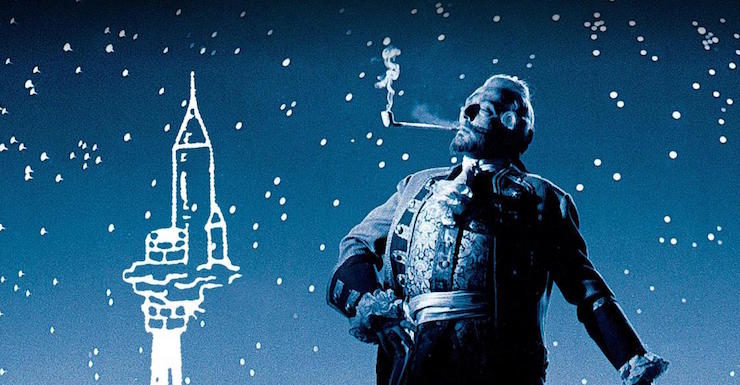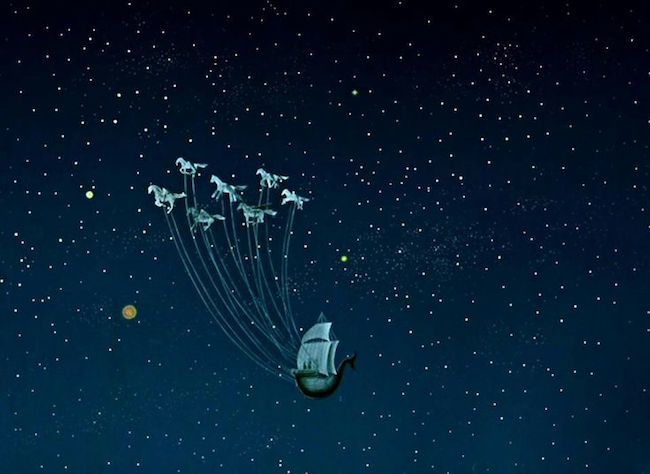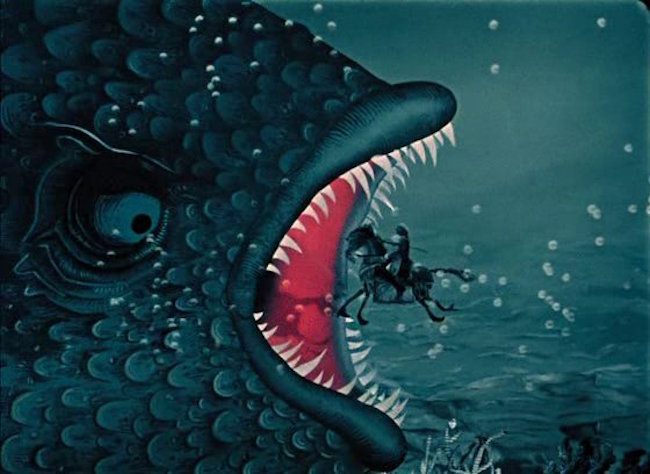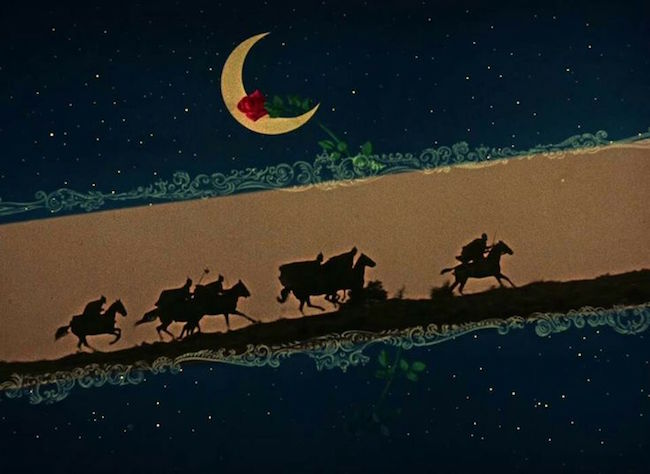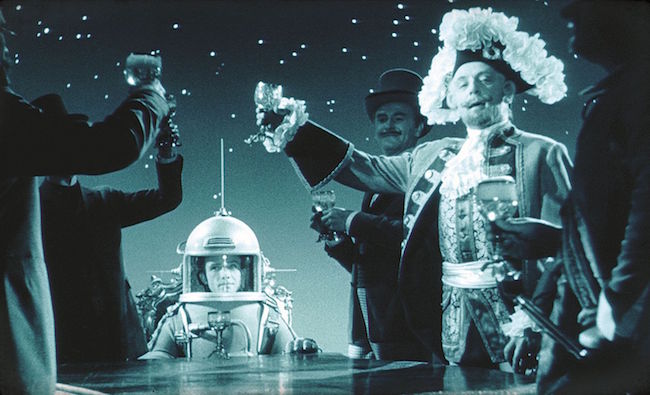In 1968, the late Brian Aldiss published Farewell, Fantastic Venus! This anthology, which reprinted writers as diverse as Edgar Rice Burroughs, Carl Sagan, C.S. Lewis, and Olaf Stapledon, celebrates the image of Venus that had once dominated science fiction stories—a planet full of jungles, swamps, adventure, and mystery—and would soon be forever eclipsed by the lifeless inferno the first space probes discovered.
I admit that this description of a British science fiction anthology from 1968 may seem an odd way to open an article on a film made seven years earlier behind the Iron Curtain, yet Aldiss’s anthology kept coming to mind as I watched Czech director Karel Zeman’s 1961 Baron Prášil, better known to Western audiences as The Fabulous Baron Munchausen. Zeman’s film opens with Tony, a stolid astronaut (or cosmonaut—we never do learn his nationality), sensibly clad in a bulky spacesuit, exiting his space capsule to plant his flag and make his giant leap for mankind. He is, of course, perturbed when he sees a whole path of footprints stretching away from his capsule.
Tony follows the footprints to a derelict nineteenth-century space capsule, and, nearby, three men in frockcoats, top coats, and waxed mustaches: the three members of the Baltimore Gun Club from Jules Verne’s From the Earth to the Moon. With them, equally unconcerned about the lunar climate and the lack of oxygen and looking quite hale for a man of 350 years, is Cyrano de Bergerac, who once wrote about empires on the moon. Baron Munchausen, who claims to be the bravest of adventurers, the wisest of diplomats, and the most irresistible of lovers, and who certainly is the greatest of raconteurs, arrives shortly thereafter astride a flying horse. Believing poor Tony, with his clunky spacesuit and his bewildered incomprehension, to be a delegate from another planet, the Baron resolves to show his new friend Earth: They depart in a sailboat towed by flying horses and land in the eighteenth century.
You can imagine how a modern American or European film would depict the voyage from the moon: the rushing CGI horses, the stars bursting overhead, the long monologue from the Baron, speaking over the rush of air and the neighing of the horses, explaining the rules of the dream world (for there must be rules). And you can also imagine how one of Zeman’s contemporaries, like Ray Harryhausen, would have operated: back-projection, stop-motion horses that, for all the care lavished on them, seem alive precisely because they’re not entirely believable. The Fabulous Baron Munchausen looks nothing like either of these alternatives; nor does Zeman’s movie look much like Terry Gilliam’s 1988 Adventures of Baron Munchausen, though Gilliam conceived his film as an homage to the Czech master.
Zeman worked with all the care of Harryhausen and all the ingenuity of Gilliam, but his great inspirations for the look of his film were two great French artists: the engraver Gustave Doré and the filmmaker Georges Méliès, director of turn of the century classics like A Trip to the Moon and Baron Munchausen’s Dream. At their best, Méliès films seem like illustrations come to life, blending animation and live action to create something strange, beautiful, and nameless. Zeman imitates his master’s techniques and effects: his live characters wander an illustrated world; many of the “sets” are illustrations by Doré, who is so important to the film that he receives billing in the opening credits.
Although there is sound, dialogue, and music, most of Baron Munchausen plays out in variously tinted monochromes: blue tints for night, red for fire and fighting, a burning yellow for the desert, and so on. At other times, Zeman plays tricks with the format of the screen—in one memorable sequence, the frame splits into three slightly slanted registers. In the bottom register, a bright red animated rose blooms, in the middle we witness a desperate horseback chase, and in the topmost slice of the screen we see the peaceful crescent moon and the blinking stars. It’s one of the most beautiful and unexpected moments I’ve seen on film.
I haven’t talked too much about the plot or characters (besides the Baron and Tony), as this isn’t a film that pays much attention to either. At just 81 minutes, there’s little room for character development, and even if there were, it would likely be overshadowed by the visual extravagances and miracles on display. As in Gilliam’s later film, the display and celebration of Imagination overshadows the quotidian concerns of more conventional filmmaking. Any of the Baron’s individual exploits—riding a cannonball, flying to the moon, slaying thousands in a single swordfight—matters less than the surfeit of wonder occasioned by their abundance.
I watched The Fabulous Baron Munchausen on the new Blu-Ray from Second Run Films. Although it’s produced by a British company, the disc is region-free and should play in any Blu-Ray player. Unlike some prior releases of Zeman films, the subtitles are clearly the work of a fluent English speaker.
At the end of the movie, Tony and the Baron, returned to space by an unlikely method, bid farewell to “the fantasists in frockcoats” and the other inhabitants of the prescientific moon, who must seek another world as yet innocent of reality; I hope they did not migrate to Venus. I think they’re doing fine—The Fabulous Baron Munchausen reminds us that the worlds of imagination are limitless. Farewells are not forever.
Matt Keeley reads too much and watches too many movies; he is helped in the former by his day job in the publishing industry. You can find him on Twitter at @mattkeeley.










